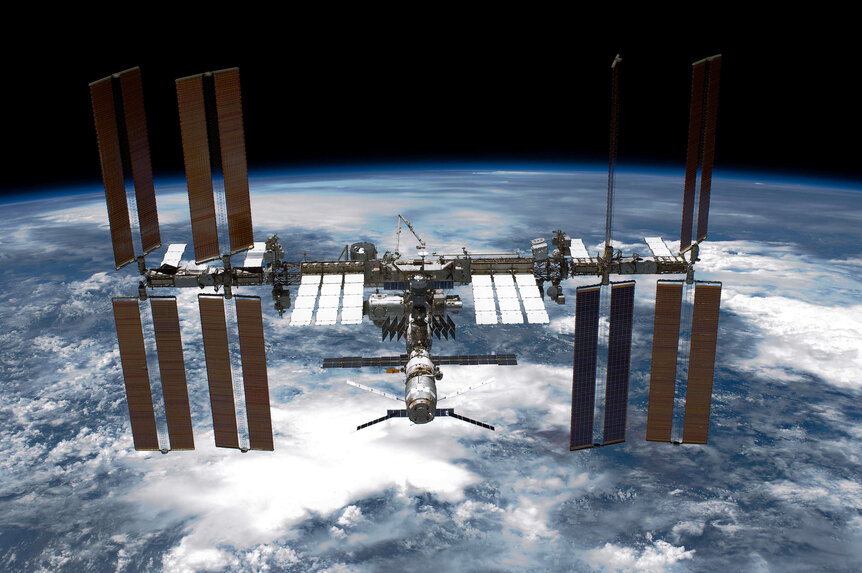Create a free profile to get unlimited access to exclusive videos, sweepstakes, and more!
International Space Station Destined for Point Nemo, the World's Spaceship Graveyard
It's the place spacecraft go to die.
In the science fiction adventure Upside Down (streaming now on Peacock) scientists and engineers can play fast and loose with their dual planets’ gravity. It’s possible in this fictional world, under the right circumstances, to go up and stay there forever. In the real world, however, what goes up must come down.
When a satellite or spacecraft reaches the end of its life, it almost always comes back to Earth eventually. For smaller satellites that’s not much of a concern; they’ll burn up in the atmosphere before they ever pose a risk to anyone on the ground. For larger chunks of space debris, like rocket stages or space stations, there’s a higher risk that fragments will survive re-entry and strike the surface.
The ISS Is Headed for the World’s Spaceship Graveyard
With that in mind, space agencies take pains to put decommissioned spacecraft down in precise locations, but it’s a necessarily chaotic process. As spacecraft hit the atmosphere, they fracture and partially burn up. Any surviving shrapnel can spread across a wide area in unexpected ways. So, you want your point of re-entry to be as far from everything else as possible, and there’s nothing more remote than Point Nemo.
RELATED: NASA Wants Ideas for How to Destroy the International Space Station
Sometimes called “the oceanic pole of inaccessibility,” Point Nemo is as far from land as it’s possible to be on Earth. If you happened to find yourself on a boat at this remote location, it’s likely that the next nearest person would be an astronaut on the International Space Station, orbiting roughly 225 miles overhead. There’s a certain poetic symmetry, then, that Point Nemo is where the ISS will ultimately end up. But it won’t be alone.
When the ISS closes up shop in 2030 and crashes into the Pacific, it will join a number of other crashed spacecraft in the world’s underwater spaceship graveyard. Space agencies around the world have dumped more than 263 pieces of space junk in that spot since 1971, according to a study. The spot is chosen for obvious reasons. Dropping spaceships on Point Nemo reduces the risk of any surviving bits striking people or property.
The International Space Station Deorbit Plan
At its present altitude, it would take a year or two for the ISS to fall to Earth on its own once all of the astronauts disembark, but that entry would be uncontrolled. Instead, participating space agencies are developing a complex plan to bring the station down in a controlled manner. At the end of its life, the station’s orbit will be allowed to decay naturally, reducing the amount of fuel needed for final maneuvers. Additional intentional maneuvers with existing propulsion systems will move the station into an even lower orbit. Lastly, a bespoke spacecraft will be used to carry out a final burn using a lot of fuel to push the station into an even lower orbit and into a controlled reentry path over Point Nemo.
RELATED: NASA wants to build a 'space tug' to safely destroy the ISS
"Eventually, after performing maneuvers to line up the final target ground track and debris footprint over the South Pacific Oceanic Uninhabited Area (SPOUA), the area around Point Nemo, ISS operators will perform the ISS re-entry burn, providing the final push to lower ISS as much as possible and ensure safe atmospheric entry," NASA wrote in the International Space Station Transition Report.
The station is expected to break up in three stages. First, the solar array and radiators will break off. Next, intact modules and truss segments will fracture. Finally, individual components will burn up. Some individual heat-resistant components are expected to survive the fiery return journey and plunge into the deep. By the time the station is retired, it will be 32 years old. And anyone in their 30s knows that if you’re going to fall, it’s important to do it in as controlled a way as possible to avoid disaster.
Catch the science fiction fairy tale Upside Down streaming now on Peacock.
































